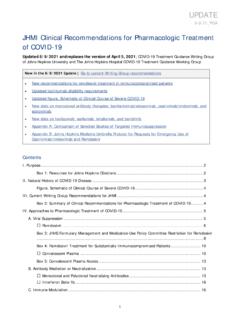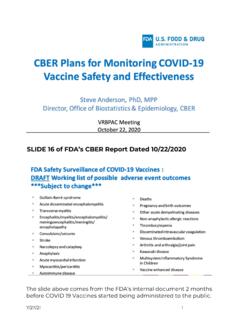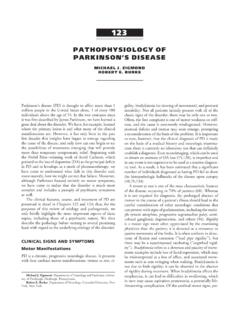Transcription of Alberta Treatment Guidelines for Sexually Transmitted ...
1 2018 Government of Alberta General Considerations for STI *Individuals at higher risk for STI include but are not limited to those having sexual contact with person(s) witha known STI, Sexually active under 25 years of age, a new sexual partner or >2 sexual partners in th e past year,use of non-barrier contraception, persons who inject drugs or other substance users, sex workers and theirclients, street involved/homeless, anonymous sexual partnering, previous STI, victims of sexual assault/abuse,men who have sex with men (MSM). Given the high rates of STI in Alberta , it is appropriate to assess for risk of andscreen for STI at routine medicalappointments. This is particularlyimportant in individuals at higher risk for STI*or in individuals where the risk ofconsequences of STI are high ( ,adolescents, pregnant women).
2 All insertive and receptive sexual practices(oral, vaginal and anal) put individuals at riskfor STI. In addition, intimate skin to skincontact may result in transmission of someSTI, including herpes simplex virus andhuman papillomavirus infections. Treatment of STI is necessary to mitigatesequelae of infection and to prevent furthertransmission. Drugs for the Treatment of notifiable STI areprovided free of charge and are replacedfollowing submission of an STIN otification Form. Some STI are under the AlbertaPublic Health Act (for copies of Notification ofSexually Transmitted Infections forms, seeSTI Resources on back page). Partner notification is a critical component ofSTI control and important in preventing furtherspread and re-infection.
3 Assistance withpartner notification is available from publichealth staff (see section on PartnerNotification on back page). Counselling about safer sex practices isimportant in individuals with or at risk for can in turn prevent re-infection andacquisition of new infections. Safer sexoptions include use of barrier contraceptives,reducing numbers of sexual partners,delaying onset of sexual debut andabstinence. Patients and contacts should abstain fromunprotected sexual intercourse until treatmentfor both is completed and for 7 days aftersingle dose therapy. Hepatitis B immunization should be offered toall individuals with an STI who have notalready been immunized. In some situations,hepatitis A and/or Human Papillomavirus(HPV) immunization may be recommended.
4 Having one STI puts one at risk for other , all individuals with an STI shouldbe screened for syphilis, HIV, gonorrhea Treatment Guidelines for Sexually Transmitted Infections (STI) in Adolescents and Adults 2018 NEW! The Notification of Sexually Transmitted Infections (STI) form is now available in a fillable pdf format 2018 Government of Alberta The Alberta Treatment Guidelines for Sexually Transmitted Infections (STI) in Adolescents and Adults 2018 has been adapted from the CanadianGuidelines on Sexually Transmitted Infections for provincial use with permission from the Public Health Agency of Canada. The Canadian Guidelines are available online at: Recommendations regarding Treatment of pediatric infections are excluded from these Guidelines .
5 In general, children diagnosed with an STI should be managed in conjunction with a Pediatric Infectious diseases specialist at a referral center and be reported to Alberta Child and Family Services Division or appropriate law enforcement agency for investigation of possible sexual abuse (see section on back page on Considerations in Persons Under 18 Years of Age). This guideline includes the level of recommendation and quality of evidence indicators for the Treatment recommendations. The indicators reflect a combination of the methodologies from the Preventive Services Task Force and the Canadian Task Force on Preventive Health Care and have been modified and simplified for use as outlined below (re-printed with permission from the Canadian Guidelines on Sexually Transmitted Infections).
6 Levels of recommendation and quality of evidence were adapted from the Canadian Guidelines for Sexually Transmitted Infections; if Alberta guide-lines differ from the Canadian Guidelines for Sexually Transmitted Infections levels of recommendation and quality of evidence are based on a com-prehensive literature review. A Strongly recommends that clinicians routinely provide the Treatment to eligible patients. Good evidence that the Treatment improves important health outcomes and concludes that benefits substantially outweigh harms. B Recommends that clinicians routinely provide the Treatment to eligible patients. At least fair evidence that the Treatment improves important health outcomes and concludes that benefits outweigh harms.
7 C No recommendation for or against routine provision of the Treatment . At least fair evidence that the Treatment can improve health outcomes but concludes that the balance of the benefits and harms is too closeto justify a general recommendation. D Recommends against routinely providing the Treatment to asymptomatic patients. At least fair evidence that the Treatment is ineffective or that harms outweigh benefits. I Evidence is insufficient to recommend for or against routinely providing the Treatment . Evidence that the Treatment is effective is lacking, of poor quality or conflicting, and the balance of benefits and harms cannot be determined. I Evidence from at least one properly randomized, controlled trial.
8 II Evidence from at least one well-designed clinical trial without randomization, from cohort or case-control analytic studies (preferably from more than one centre), from multiple time-series studies or from dramatic results inuncontrolled Evidence from opinions of respected authorities based on clinical experience, descriptive studies or reports of expert committees. LEVELS OF RECOMMENDATION QUALITY OF EVIDENCE CHLAMYDIA Urethral, cervical, pharyngeal, conjunctival infection Non-Pregnant/Non-Lactating Adults Preferred azithromycin 1 g PO as a single dose (A-I; A-II for eye) Alternate doxycycline 100 mg PO BID for 7 days (A-I; A-II for eye)Pregnant/Breastfeeding Women Preferred azithromycin* 1 g PO as a single dose (B-I) or amoxicillin 500 mg PO TID for 7 days (A-I) *Available data suggests that azithromycin issafe and effective in pregnant is the preferred Treatment forconjunctival infections in Infection Preferred doxycycline 100 mg PO BID for 7 days (A-II) Alternateazithromycin 1 g PO as a single dose (A-II) Considerations All patients with extragenital infections should also have genitourinary specimens submitted for C.
9 Trachomatis and nucleic acid amplification test (NAAT). Co- Treatment for gonorrhea (GC) (see relevant section) should be provided if there is a positive test for GC or if Treatment is being provided before test results are available. If vomiting occurs > 1 hour post administration of azithromycin, a repeat dose is not required. Doxycycline is contraindicated in pregnant women. Contacts (all chlamydia cases) All contacts in the last 60 days, regardless of symptoms or signs, must be located, examined, tested and treated. It may be necessary to extend this time period until a sexual contact is identified. Follow-Up (all chlamydia cases) Test of cure (TOC) is not routinely indicated if recommended Treatment is administered, symptoms and signs disappear and there is no re-exposure to an untreated partner unless: compliance is sub-optimal or uncertain patient is pre-pubertal patient is pregnant non-genital site involved ( , eye,rectum, pharynx) the Treatment agent used is not listedas the preferred or alternate treatmentin this guideline TOC using NAAT, should be performed 3-4 weeks after the completion of Treatment .
10 Re-screening of all individuals diagnosed with chlamydia (CT) is recommended after 6 months. Neonates born to women with untreated CT need to be closely monitored for signs of CT( , conjunctivitis, pneumonitis). Prophylactic Treatment is not recommended unless follow-up cannot be guaranteed. 2018 Government of Alberta Treatment and follow-up testing of all suspected or confirmed cases of syphilis should be done in consultation with STI Centralized Services. Non-Pregnant Adults (All cases including HIV-infected) Primary, Secondary, Early Latent Preferred Long-acting benzathine penicillin G mu (Bicillin L-A) IM as a single dose (A-II;C-II for HIV-infected) Alternate (Only for penicillin allergic patients) doxycycline 100 mg PO BID for 14 days (B-II; C-III for HIV-infected) Late Latent Preferred Long-acting benzathine penicillin G mu (Bicillin L-A) IM weekly for 3 consecutive weeks (A-II;C-II for HIV-infected) Alternate (Only for penicillin allergic patients) doxycycline 100 mg PO BID for 28 days (B-II.)














